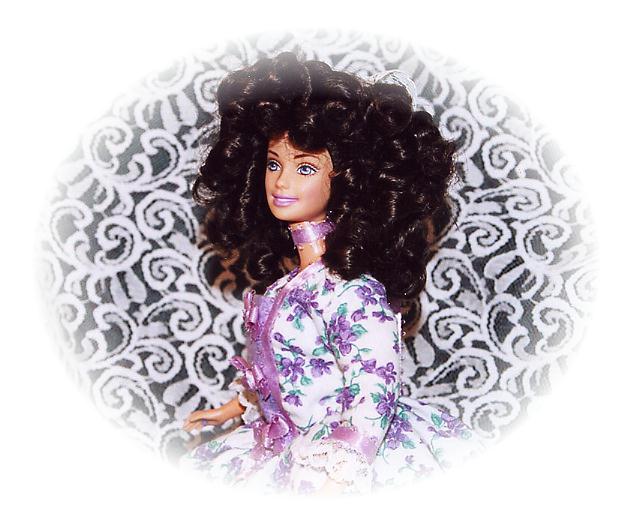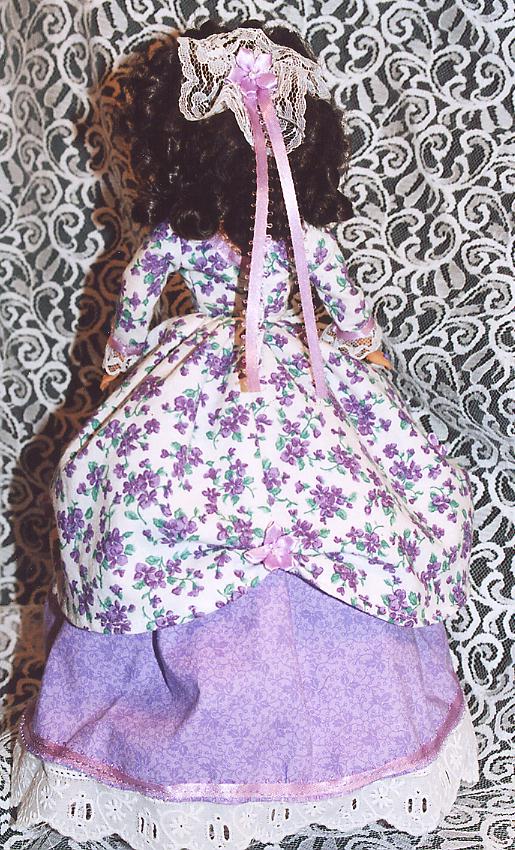 |
 |
 |
 |
 |
 |
 |
|
This doll is meant to evoke an American version of the Rococo style made popular in Europe, with its fabulous, feminine frills,
bows and curls, towering hair, and skirts that can barely fit through a door (think of the fashions in the movies "Dangerous
Liaisons," "Valmont," "The Madness of King George," and "The Scarlet Pimpernel" from the
1980's starring Jane Seymour).
Abigail is a society girl, of a good family from one of the larger cities in the new country, like Boston or New York,
in that heady time when the Revolution had concluded, a government was being formed, and life and trade resumed and blossomed.
Abigail is decked out in her finest to attend a ball, where her gentleman with fine lace cuffs and velvet frock-coat will
sweep off his tri-corn hat and ask for a dance.
The latest fashions from Paris would have been all the rage throughout Europe and America--the alliance with France during
the Revolution brought about some cultural exchange with the former colonies, and the extravagant fashions of the court of
Louis XVI and Marie Antionette defined Rococo style before the French Revolution brought in a new society and simpler fashion.
Dress shops in American cities would have been able to offer (although they would have been several months behind!) catalogs
of European fashions and patterns, imported fabrics, and mannequins dressed in the latest styles from abroad or made locally
for their clientele to choose from.
|
 |
|
 |
 |
 |
 |
 |
 |
 |
|
| Abigail |

|
Mercy Otis Warren (1728-1814), an excerpt from her history, "The Rise, Progress, and Termination of the American Revolution,"
describing the country after the close of the war:
"The mind now willingly draws a veil over the unpleasing part of the drama, and indulges the imagination in future
prospects of peace and felicity; when the soldier shall retreat from the field, lay by the sword, and resume the implements
of husbandry -- the mechanic return to his former occupation, and the merchant rejoice in the prosperous view of commerce;
when trade shall not be restricted by the unjust or partial regulations of foreigners; and when the ports of America shall
be thrown open to all the world, and an intercourse kept free, to reap the advantages of commerce extended to all nations."
|
|
 |
|
 |
 |
 |
 |
|
| Abigail |

|
Abigail's outfit comes in three pieces: an overdress, skirt, and petticoat. The bodice of the overdress has the squared,
low-cut neckline of the times; the front of the bodice is a stiffened panel which drops to a low-waisted point in front and
is cut higher at the sides and back. The bodice is two-toned: the front piece is in a sprigged lavender cotton material,
the sides, sleeves and back in a complementary lavender floral print on a white background. The overskirt, in the floral
material, is attached to the bodice, and deeply gathered at the tiny waist, and shirred along the side and in the back, creating
a drapery effect over the full skirt of sprigged lavender. Satin ribbon trims the front of the bodice and overskirt, the
three-quarter sleeves, and hem of the skirt. Three jaunty bows in lavender satin march down the front of the bodice, while
lavender satin flowers trim the overskirt. There is lace at her cuffs and hem of her skirt.
| Abigail |

|
Drawings of actual American costumes of 1778-1790:
| American costumes of 1778-1790 |

|
|
|
 |
 |
 |
|
 |
 |
 |
|
Cinematic Inspiration:
| Dangerous Liaisons |

|
| The Scarlet Pimpernel |

|
| Scarlet Pimpernel |

|
| The Aristocrats |

|
Top left: Michelle Pfeiffer and John Malkovitch as Madame D'Anglais and Valmont in "Dangerous Liaisons"
Above left: the fashionable ladies of "The Aristocrats"
Top middle and right: Jane Seymour and Anthony Andrews as Marguerite and Percy in "The Scarlet Pimpernel" --
co-starring Jane Seymour's wonderful hairstyles(an inspiration for Abigail)!
Click here for a web-site listing movie costume dramas dealing with the 18th century.
|
|
 |
 |
 |














